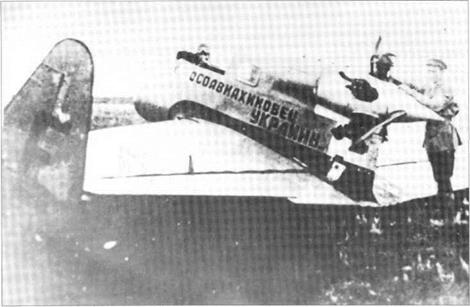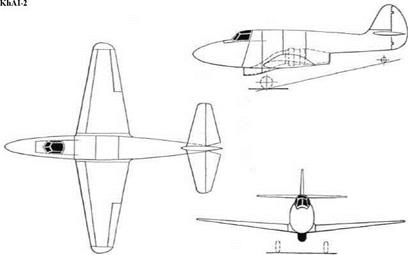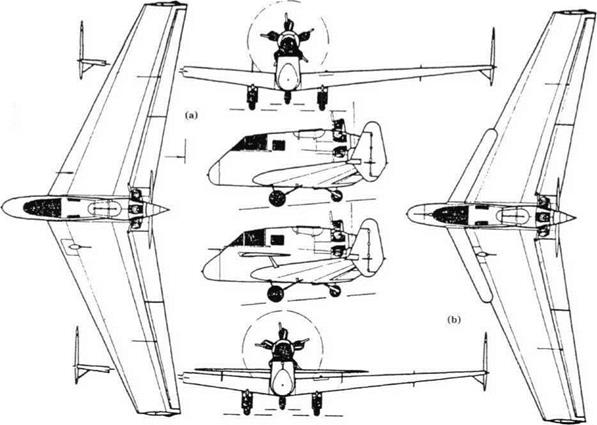Kharkov KhAI-4
Purpose: To test a tailless light aircraft. Design Bureau: Kharkov Aviation Institute, joint design by P G Bening, A A Lazarev and AAKrol’.
Also known as the Iskra (spark) and as the Osoaviakhimovets Ukrainy for the local Osoaviakhim branch, the KhAI-4 was completed in summer 1934, and first tested in October of that year by B N Kudrin. He found the elevens almost useless, but discovered that at ISOkm/h (112mph) the KhAI-4 could just become airborne provided the airfield was bumpy! Once in the air he found that the downthrust of the propeller (because of its sloping thrust axis) resulted in a poor rate of climb, while the small moment arm of the elevens made longitudinal control extremely poor. To cap it all, the wingtip surfaces, away from the slipstream, were ineffective, making the aircraft directionally unstable. Kudrin was able to creep round the circuit by holding the control column neutral, and to land at high speed with a small angle of attack, not trying to raise the nose. He did fly the KhAI-4 twice more, but that was enough.
The KhAI-4 tested several ideas and even actual components which were later built into the larger Avia vnito- 3. Its obj ecti ve was to explore handing of a tailless machine, and also one with a castoring nosewheel (the first such landing gear in the Soviet Union). Aerodynamically it comprised a short central nacelle on a wing tapered on the leading edge, fitted with various controls. Initially the wing had six trailing-edge surfaces, all operated differentially by rotation of the pilot’s handwheel. A push/pull movement operated the two innermost surfaces, which were thus elevens. Movement of the pedals operated rudders on the wingtip fins. Later swept-back wings with distinct ailerons and elevators were tested, and the drawing even shows the addition of small fixed foreplanes. Despite the difference in size and weight the engine was the same type of l00hp M-ll as used for the Aviavnito-3, but driving a pusher propeller. The short landing gears had balloon tyres, the main shock struts having a hydraulic connecting pipe so that, if one wheel went over a bump, the other leg would extend to hold the wings level and avoid scraping the tip. The construction was wood, but with overall fabric covering. The nacelle had two seats in tandem.

 The Kharkov designers deliberately embarked on this tricky and untried layout, but failed to make it work. Dropping the idea was probably largely due to the pilot’s wish to survive.
The Kharkov designers deliberately embarked on this tricky and untried layout, but failed to make it work. Dropping the idea was probably largely due to the pilot’s wish to survive.
|
Kharkov KhAI-2
Purpose: To build a turbojet aircraft. Design Bureau: Arkhip M Lyul’ka and A P Yeremenko, working at Kharkov Aviation Institute.
Dimensions
Span 6.95m 22 ft 9% in
Length 7.2m 23 ft 7Vm
 This drawing was discovered in 1993. It shows a small aircraft proposed by Yeremenko to test the first turbojet designed by Lyul’ka, who later became one of the Soviet Union’s greatest jet engineers. There are two puzzles: the designation KhAI-2 is conspicuously absent from the official history of the KhAI published in 1990; and this designation was in any case used for the Institute’s modification of the Po-2 (likewise not mentioned in the book, perhaps because it was not an original Kharkov design). The drawing shows the centrifugal turbojet (which Lyul’ka had not made but calculated to give 525kg [l,1571b] thrust) fed by a ventral inlet, with the nozzle under the rear fuselage. It also suggests that the cockpit could be jettisoned in emergency. Co-author Gunston believes the date must have been rather later than 1936, but this can still claim to have been the world’s first design for a jet aircraft.
This drawing was discovered in 1993. It shows a small aircraft proposed by Yeremenko to test the first turbojet designed by Lyul’ka, who later became one of the Soviet Union’s greatest jet engineers. There are two puzzles: the designation KhAI-2 is conspicuously absent from the official history of the KhAI published in 1990; and this designation was in any case used for the Institute’s modification of the Po-2 (likewise not mentioned in the book, perhaps because it was not an original Kharkov design). The drawing shows the centrifugal turbojet (which Lyul’ka had not made but calculated to give 525kg [l,1571b] thrust) fed by a ventral inlet, with the nozzle under the rear fuselage. It also suggests that the cockpit could be jettisoned in emergency. Co-author Gunston believes the date must have been rather later than 1936, but this can still claim to have been the world’s first design for a jet aircraft.











